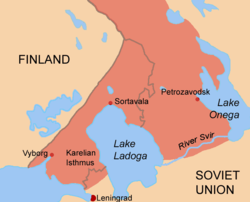Finnish military administration in Eastern Karelia
| Military Administration in Eastern Karelia Itä-Karjalan sotilashallinto |
||||||
| Military administration by Finland | ||||||
|
||||||
|
||||||
|
Finnish advance to Eastern Karelia during the Continuation War. The military administration extended further north. Red area inside the gray borders was re-annexed directly to Finland on December 9, 1941. |
||||||
| Capital | Mikkeli (1941) Joensuu (1941–1943) Petrozavodsk (1943–1944) |
|||||
| Military Commander | ||||||
| • | 1941–1942 | Väinö Kotilainen | ||||
| • | 1942–1943 | J. V. Arajuuri | ||||
| • | 1943–1944 | Olli Paloheimo | ||||
| Historical era | World War II | |||||
| • | Military occupation | 1941 | ||||
| • | Disestablished | 1944 | ||||
The Finnish military administration in Eastern Karelia was an interim administrative system established in those areas of the Karelo-Finnish Soviet Socialist Republic (KFSSR) of the Soviet Union which were occupied by the Finnish army during the Continuation War. The military administration was set up on July 15, 1941 and it ended during the summer of 1944. The goal of the administration was to prepare the region for eventual annexation into Finland.
The administration did not encompass the territories ceded to the Soviet Union in the Moscow Peace Treaty and subsequently recaptured by the Finns during the summer offensive of 1941.
Finnish interest in Russian Karelia goes back to the 19th century. Eastern Karelia was seen as the cradle of Finnish culture and the ancient land of the heroic sagas of the Kalevala. Along with the rise of Finnish Anti-Russian sentiment, the "Karelia question" became politicized. During and after the Finnish civil war several voluntary expeditions were launched with the intended goal of liberating the Karelian "kindred people", without success.
The Continuation War and a trust in a quick German victory over the Soviet Union once again gave rise to Finnish irredentism. The legality of the Finnish claims on Eastern Karelia was justified by both ethno-cultural and military security factors. During the spring of 1941, when the Finnish political leadership understood the full extent of the German plans concerning the Soviet Union, president Ryti commissioned professor of geography Väinö Auer and historian Eino Jutikkala to demonstrate "scholarly" that Eastern Karelia formed a natural part of the Finnish living space. The resulting book Finnlands Lebensraum ("Finland's Living Space") was published in the autumn of 1941, and was intended to legitimize Finnish claims and actions to the international audience. A similar book by historian Jalmari Jaakkola, Die Ostfrage Finnlands ("Finland's Eastern Question") was published in the summer of the same year.
...
Wikipedia



